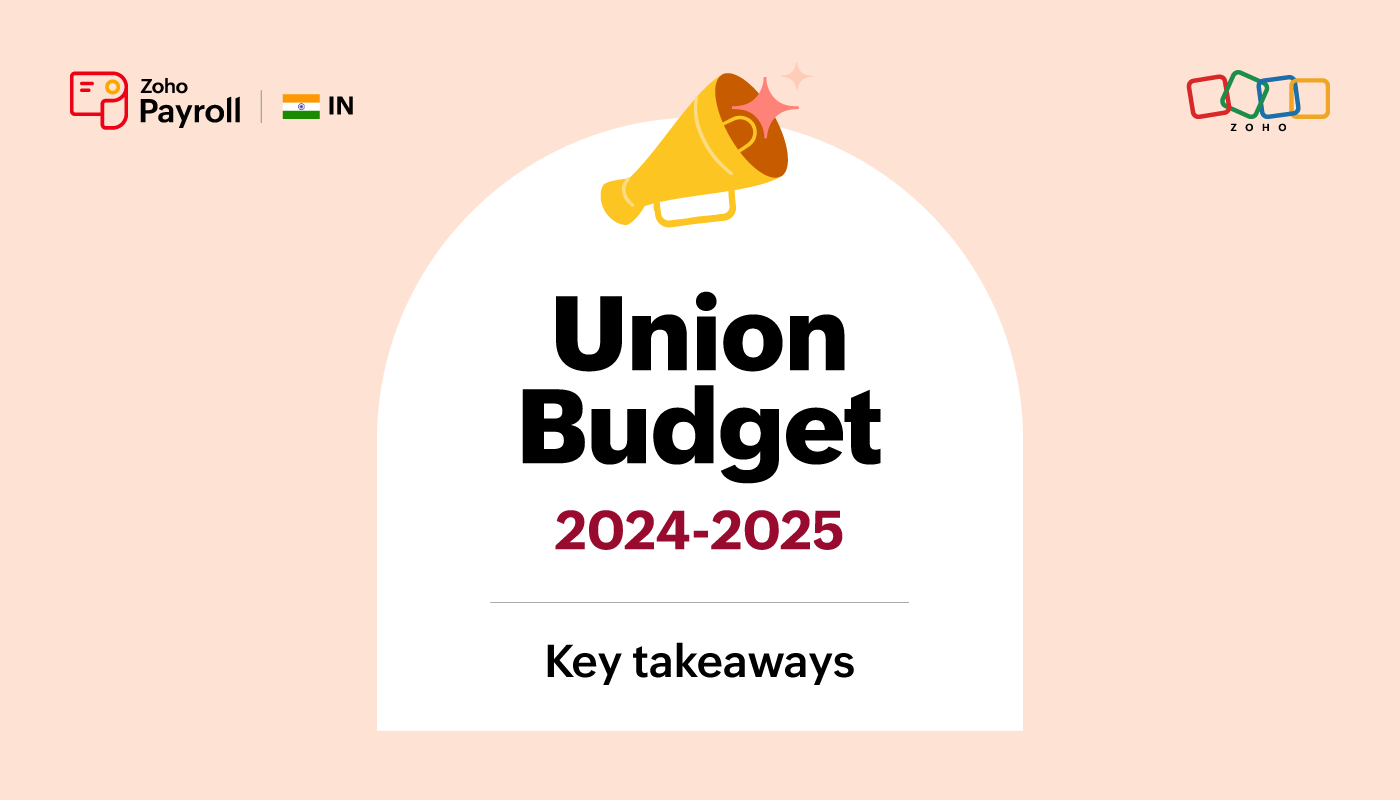- HOME
- Taxes and compliance
- Union Budget 2024 highlights, revised tax slab rates, and more
Union Budget 2024 highlights, revised tax slab rates, and more
Union Minister of Finance and Corporate Affairs, Nirmala Sitharaman, recently presented the Budget 2024-2025 at the parliament. The budget aims to support MSMEs, and boost employment and skilling in India.

Here are the key points of the budget that you should know as an employer in India.
- The new regime income tax rates for salaried individuals have been revised.
- The standard deduction in the new tax regime is now ₹75,000, up from ₹50,000.
- The government will review the Income Tax Act, 1961, to make it concise and easier to understand.
- A 12-month Internship opportunity for 1 crore youth over the next 5 years, offering real-life work experience, a monthly ₹5,000 allowance, and a one-time ₹6,000 support payment.
- All new freshers in formal sectors who earn less than ₹1 lakh in a month will receive a one-month wage in three instalments, up to ₹15,000.
- Employers will receive up to ₹3,000 per month in PF contributions for new hires earning less than ₹1 lakh per month, for a period of two years.
- Both employees and employers in manufacturing will receive PF contribution incentives during the first four years of employment, provided the employee's salary is less than ₹1 lakh per month.
- The deduction limit for employers' contributions to the National Pension System (NPS) in the new tax regime has been raised from 10% to 14% of employees' basic salary.
Changes in income tax rates
Under the new tax regime, the standard deduction for salaried individuals and pensioners is set to rise from ₹50,000 to ₹75,000. This change means individuals earning up to ₹7.75 lakh annually do not have to pay income tax by utilising the standard deduction and the rebate under section 87A.
The tax structure of the new tax regime has also been revised to help employees save up to ₹17,500 in a year.
| Net taxable income | Percentage of tax applicable |
| Up to 3 lakh | 0% |
| 3 lakh to 7 lakh | 5% |
| 7 lakh to 10 lakh | 10% |
| 10 lakh to 12 lakh | 15% |
| 12 lakh to 15 lakh | 20% |
| Above 15 lakh | 30% |
No changes have been made to the old tax regime, however taxpayers still have the option to switch to it.
Employee-linked incentives - What are they?
In order to boost job creation in the country, the government announced four schemes, majorly focusing on first-time employees. These schemes will be based on enrolment of employees in the Employees Provident Fund.
Scheme A: Under this scheme, the government will offer a month's wage to all freshers joining the formal sector. Registered first-time PF employees will receive up to ₹15,000 in 3 instalments. To qualify, their salaries must be ₹1 lakh or less per month.
Scheme B: This program aims to create more jobs in the manufacturing sector. For the first four years of employment, employees who less than ₹1 lakh per month and their employers will get incentives tied to their PF contributions.
Scheme C: For every new hire in any sector earning up to ₹1 lakh per month, the government will contribute up to ₹3,000 per month towards their PF for 2 years.
Internship opportunity: This aims to provide internship opportunities in 500 top companies for 10 million young people over the next 5 years. Each intern will spend 12 months gaining real-life work experience and will receive an allowance of ₹5,000 per month and a one-time support payment of ₹6,000. Companies will cover the training costs, and 10% of the internship expenses can be from their CSR funds.
Changes made to NPS contributions
To increase social security benefits for employees, the government plans to raise the contributions employers make to the National Pension System (NPS) on behalf of their employees. Currently, employers are allowed to contribute up to 10% of an employee's basic salary to the NPS, but this will be increased to 14%. This benefit is available only in the new tax regime.
Assume your basic monthly salary is ₹50,000, and you're enrolled in the NPS. Previously, your employer may have contributed up to 10% of ₹50,000, which is ₹5,000, to your NPS account each month. With the new proposal, your employer can contribute 14% of your salary, which is ₹7,000, to your NPS account, provided you've opted for the new tax regime.
Additionally, for employees working in the private sector, public sector banks, and other government-related companies who choose the new tax regime, they will also get a tax deduction for this 14% contribution from their salary. This means these employees can reduce their taxable income by the amount their employer contributes to the NPS.
For employees choosing the old tax regime, a tax exemption of up to 10% is applicable.
Taxation of capital gains
Taxation of some short-term capital gains (profits that arise when you sell a financial asset within a year of purchase) and long-term capital gains are also changing.
The tax rate for short-term capital gains on equity shares, equity mutual funds, and business trust units (if you paid the Securities Transaction Tax) will increase from 15% to 20%.
Long-term gains on both financial and non-financial assets will be taxed at 12.5%. To reduce the tax burden, the government is increasing the tax-free limit on long-term capital gains from ₹100,000 to ₹125,000. This applies to gains made on shares, equity mutual funds, and business trusts where the Securities Transaction Tax (STT) is paid.
However, unlisted bonds and debentures, debt mutual funds, and market-linked debentures will be taxed at regular rates, regardless of how long you hold them.
For further understanding, take a look at the booklet on Budget issued by the government here: https://www.indiabudget.gov.in/doc/bh1.pdf
Or read the budget speech from here: https://www.indiabudget.gov.in/



